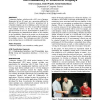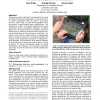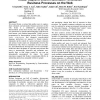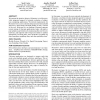CHI
2007
ACM
14 years 12 months ago
2007
ACM
In navigating large information spaces, previous work indicates potential advantages of physical navigation (moving eyes, head, body) over virtual navigation (zooming, panning, fl...
CHI
2007
ACM
14 years 12 months ago
2007
ACM
Retrieving the stylus of a pen-based device takes time and requires a second hand. Especially for short intermittent interactions many users therefore choose to use their bare fin...
CHI
2007
ACM
14 years 12 months ago
2007
ACM
Physical controls such as knobs, sliders, and buttons are experiencing a revival as many computing systems progress from personal computing architectures towards ubiquitous comput...
CHI
2007
ACM
14 years 12 months ago
2007
ACM
Volumetric displays, which provide a 360? view of imagery illuminated in true 3D space, are a promising platform for interactive 3D applications. However, presenting text in volum...
CHI
2007
ACM
14 years 12 months ago
2007
ACM
We present a qualitative study of 20 American Orthodox Jewish families' use of home automation for religious purposes. These lead users offer insight into real-life, longterm...
CHI
2007
ACM
14 years 12 months ago
2007
ACM
Web search engines present search results in a rank ordered list. This works when what a user wants is near the top, but sometimes the information that the user really wants is lo...
CHI
2007
ACM
14 years 12 months ago
2007
ACM
Biological research in the field is constrained by the speed and difficulty of species determination, as well as by access to relevant information about the species encountered. H...
CHI
2007
ACM
14 years 12 months ago
2007
ACM
We present Koala, a system that enables users to capture, share, automate, and personalize business processes on the web. Koala is a collaborative programming-bydemonstration syst...
CHI
2007
ACM
14 years 12 months ago
2007
ACM
Museums increasingly deploy new technologies to enhance visitors' experience of their exhibitions. They primarily rely on touch-screen computer systems, PDAs and digital audi...
CHI
2007
ACM
14 years 12 months ago
2007
ACM
We present the iterative design of Momento, a tool that provides integrated support for situated evaluation of ubiquitous computing applications. We derived requirements for Momen...




